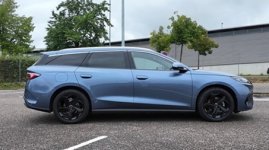Overview & key specs
- The Seal 6 DM-i is BYD’s plug-in hybrid (PHEV) in the “Seal / Sea” series. In Europe, the Touring version is the wagon (“estate”) body.
- BYD claims a combined (fuel + electric) WLTP range of up to 1,505 km for the model variants.
- The electric-only WLTP range is quoted as up to ~105 km (for higher battery variant) in some spec sheets.
- In Europe, BYD claims for the wagon: 500 L boot behind rear seats, expandable to 1,535 L with the rear seats folded.
- Powertrain: the base internal combustion engine is a 1.5 L, paired with electric motor(s) in BYD’s DM-i (Dual Mode Intelligence) hybrid system.
- Performance: BYD lists 0–100 km/h in ~8.5 s for wagon / higher spec trim.
- Top speed is claimed ~180 km/h for the model.
These are manufacturer/press claims and need to be validated in real-world testing.

Driving Impressions & Review Insights
From the early “first drive” / review articles:
- EV Fleet World reports that BYD claims “more than 932 miles” (≈ 1,500 km) combined in one of their promotional materials.
- In practice, reviewers caution that real combined range will depend heavily on driving style, electric vs engine usage, speeds, and local conditions. (As with all PHEVs, the claimed maximum is under favorable conditions.) (Implicit in reviews)
- The electric mode (~100 km WLTP) is useful for many city and daily drives; the ICE kicks in for longer trips. Reviewers note that the transition between modes is smooth in BYD’s DM-i system. (Mentioned in first drive review context)
- The wagon version offers strong practicality (cargo space, utility) which puts it in appeal against German estates (Audi, BMW, Mercedes) for those wanting EV/hybrid plus utility.
One caution from broader BYD reviews: hybrid systems tend to perform best when the battery is well charged; if you habitually deplete the battery and rely mostly on the petrol engine, the fuel economy advantage shrinks (as with all hybrids). (General hybrid/PHEV insight—not BYD-specific)
Against German Rivals — Strengths & Weaknesses
Strengths
- Range & flexibility
The claimed 1,500 km total range is a strong marketing hook. It positions the Seal 6 Touring as a long-distance capable hybrid that bridges the gap between EV range anxiety and ICE range.
The ~100 km electric range covers many daily use cases. - Utility & versatility
The wagon body gives it more cargo and flexibility than typical sedans or compact SUVs. The large boot, foldable seats, and good load capacity are competitive. - Technology & features
BYD tends to pack advanced features (infotainment, connectivity, ADAS) at aggressive pricing. The Hybrid / DM-i system is fairly mature in BYD’s product line. - Cost / value proposition
For buyers wanting a hybrid wagon with strong electric capability, the Seal 6 Touring could undercut some German offerings especially when incentives/subsidies apply.
Weaknesses / Challenges
- Real-world vs claimed numbers
As always, the “up to 1,500 km” is under ideal conditions (full battery + fuel + favorable terrain/speed). Real consumption under highway conditions may be much less. - Brand / reputation / build quality perception
German brands (Audi, BMW, Mercedes) have a legacy of durability, refinement, and brand trust. BYD is gaining ground, but some buyers will be skeptical about long-term reliability, service, parts, and resale value, especially in Europe. - Service / parts infrastructure
German marques have extensive dealer and service networks across Europe. BYD’s network is expanding, but in many regions it’s still developing, which may mean longer wait times or higher costs for repairs, calibration, parts. - Safety / certification & crash ratings
German cars often undergo rigorous Euro NCAP / German crash testing. The Seal 6 Touring may lack comparable published crash test performance in all markets. Buyers will want to ensure local homologation and safety ratings. - Driving dynamics & refinement
German estates are often benchmarked for excellent ride quality, chassis dampening, noise insulation, and handling balance. The Seal 6 Touring may lag slightly in “premium feel” — e.g. in suspension feedback, NVH (noise, vibration, harshness), finer drive nuances. - Battery / hybrid complexity & degradation
Hybrid systems add complexity (battery, control electronics, additional motors). Longevity, warranty, battery health over many years/routes is a concern especially for buyers comparing to known German reliability.
Verdict / Summary
The BYD Seal 6 DM-i Touring is a bold and compelling hybrid wagon offering. Its main trump card is the “best of both worlds” combination: a significant electric range (~100 km) plus a long total range when combining petrol + electric, all wrapped in a practical estate format.
Against the German estates (e.g., Mercedes E-Class Estate, BMW 5 Series Touring, Audi A6 Avant etc.), it competes by trading pure prestige and refinement for value, flexibility, and modern hybrid tech. For buyers who prioritize utility, lower operational cost, and advanced electrified drivetrain over brand cachet or showroom prestige, the BYD could be a very attractive alternative.
However, success in real world driving will depend heavily on:
- How closely real consumption matches claimed figures
- The local service & support infrastructure
- Consumer confidence in BYD’s long-term reliability
- How well BYD addresses refinement, safety, and driving feel vs German benchmarks
